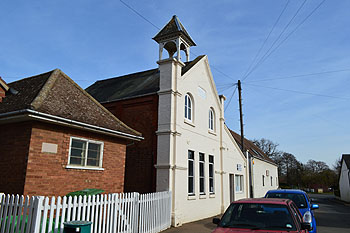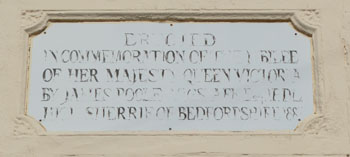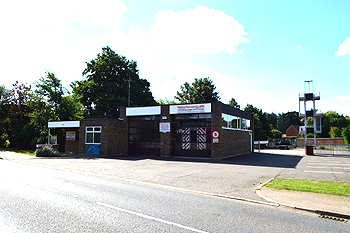Potton Fire Stations

The old fire station, now town council offices, March 2013
Following the Great Fire of Potton in 1783 there was, no doubt, demand for a properly functioning fire brigade. We know that there was some sort of local brigade by 1810 because in that year the churchwardens’ accounts refer to “Mr. Hatley’s bill for church work and engines £4 15s. 0d.” [P65/4/14]. In 1812 a dozen new buckets were bought from the Sun Fire Office and in 1814 the engine was once again repaired, costing £13/12/6 [P64/5/14]. More repairs were undertaken in the late 1830s [P64/21/8e]. The fire engine house seems to have been built on land given by the Lord of the Manor, Mr. Whitbread.
At this date fire engines were simple horse drawn or manhandled carts on which sat a manual pump to which hoses could be attached. By the end of the 19th century the manual pump had been replaced by a more powerful steam driven device and so the fire engines were often known as steamers.
Despite the various repairs the engines were not in a very good state by 1844 and a vestry minute [P64/8/1] notes: “It was resolved that Mr. Miller inspect the Fire Engines and report the state of them to the churchwardens with a view to their being put into an efficient state”.
The Bedfordshire Mercury of 10th October 1859 reported on a serious fire in a steam mill in the centre of the town and commented on the efficiency, or lack of it, of the town brigade. An excerpt commenting on the brigade reads as follows: “The town engines, if they are worthy of that name, were at once sent for, and on their arrival the men in charge used their utmost exertions to prevent the devouring element from spreading to the adjoining buildings and property. But in spite of everything that could be done the fire appeared to rage with greater fury than ever, and in a short time there was very reasonable ground for fearing that the mill would not be the only place that would be destroyed. And well it might rage, for with two such engines as these which were brought to bear on the flames it was next to an impossibility to extinguish them, and one might as well expected to have put out the great fire at Messrs Pickfords a year or two ago with half a dozen water squirts such as children play with, as to have imagined for one moment that nay good would arise from such a trumpery supply of water as they discharged”. A fire engine from Biggleswade proved as useless as those from Potton and only the private fire engine of the Whitbread family made any difference.
In 1878 a Volunteer Fire Brigade was formed in the town and soon tested by a terrible fire in June that year, which caused significant damage in the block bounded by Blackbird Street, Sun Street, Bull Street and Chapel Street. The Bedfordshire Mercury noted on 12th April 1879 that there had been a false alarm in order to test the brigade. It noted that the brigade’s efficiency was crictically hampered by the fact that they did not have their own horses and had to borrow some whenever they were needed. The following year, however, the brigade was complimented in the paper on the way it put out a local fire.
In 1882 the local gas company refused to supply gas to the engine house in order to light it. The Bedfordshire Mercury of 27th September 1884 reported that it took the brigade an hour to reach a serious fire in Waresley [Cambridgeshire], just five miles away.
In 1889 the engine house, which had been enlarged, was re-opened. The Bedfordshire Mercury reported on 8th February 1889: “An interesting gathering took place on Friday, the 8th instant, the occasion being the opening of the Engine House and new Reading Room. The engine house having previously consisted only of the room where the engine and implements were housed, the Brigade were compelled to hold their meetings at a public-house and they had long desired to have a private room of their own. This want having been known to Mr. J. Poole Wagstaff, of Manor Park, he generously undertook to supply, entirely at his own expense, the needed addition. Before doing this Mr. Wagstaff endeavoured to acquire a suitable site which would permit of a town hall, institute and reading room being constructed under one roof but failing to obtain one, he gave instructions to Mr. Samuel Woodman, builder, to carry out the wishes of the Brigade. The roof of the engine house was taken off and the walls raised, and rooms, consisting of a reading room, dressing room and lavatory, constructed. The rooms and match-boarded and varnished inside, and the dressing room fitted with lavatory [i.e.a wash basin] &c. Over the roof a handsome bell turret (the design of Mr. Wagstaff) has been erected, and a powerful bell hung; whilst the inside of the rooms have been fitted with gas. A large and elegant lamp has been fixed over the door, above which is a stone bearing the following inscription: - “Erected in commemoration of the Jubilee of Her Majesty Queen Victoria, by J. Poole Wagstaff, J. P., D. L., High Sheriff of Bedfordshire 1887””.
“On the 8th Mr. Wagstaff, at the request of the Brigade, attended and formally opened the rooms and dedicated them to the use of the Brigade. He said that he was pleased to have been enabled to add to the comfort of so useful a body of men, and hoped they might live long to enjoy the use of the rooms. He asked them all to do him the honour of dining with him”.

Plaque on the old fire station March 2013
In 1897 the clerk to the parish council was instructed to make enquiries as to how the council could take over management of the brigade’s appliances “with a view of granting money to keep the same in repair”. It was subsequently proposed that £10 a year be allowed to keep the appliances in working order and that a committee to inspect the appliances be formed [PCPotton1/1/1]. Subsequent minutes detail repainting of the engines, supplies of new hoses and other maintenance. A very important step was taken in 1913 when thirty three fire hydrants and standpipes were erected to supply water [PCPotton1/1/1].
![Potton Fire Station and Reading Room about 1900 [Z1138/91]](/CommunityHistories/Potton/Images/Potton Fire Station and Reading Room about 1900 [Z.jpg)
Potton Fire Station and Reading Room about 1900 [Z1138/91]
In 1916 the decision to maintain the appliances itself was reversed by the parish council. The minute reads: “That the parish Council appoint the Fire Brigade to maintain and manage the Parish Fire appliances, to have sole control at all fires and … have appliances tested”. In the case of a fire the Parish Clerk was to submit an account of the charges to the various Fire Insurance offices for their use of the parish appliances [PCPotton1/1/1].
In 1918 Mr. Whitbread offered the site of the engine house to the parish council who were to maintain it as a fire station. The offer was accepted and a conveyance drafted and signed on 3rd June that year [PCPotton1/1/1]. The following year the council again decided that they should look after the fire engine. A minute reads that the council was “to ask the Fire Brigade to seriously consider the advisability of vesting the Steam Fire Engine in the Parish Council” [PCPotton1/1/2]. A month later it was proposed “that the Fire Brigade be requested to return to the Parish fire station all hose and appliances purchased by the Parish Council” [PCPotton1/1/2]. A Fire Appliances Committee was formed in 1920.
In 1938 all county, borough, rural and urban district councils were constituted as fire authorities by the Fire Brigades Act. Authorities, in the case of Potton this would have been Biggleswade Rural District Council, were required to provide “the services for their borough or district of such a fire brigade and of such fire engines, appliances and equipment as may be necessary to meet efficiently all normal requirements”. In 1941 all fire brigades in the country were combined under the auspices of the National Fire Brigade to allow better co-operation in attending large bombing incidents. The Fire Services Act 1947 transferred local brigades to county councils or county boroughs, Sandy’s station and brigade thus became part of Bedfordshire Fire Brigade, now [2013] Bedfordshire and Luton Fire and Rescue Service.
In 1955 the fire station was again enlarged. New accommodation was provided and the cost was nearly £5,000 [FSM1]. The station was formally re-opened on 20th July 1957. The bay for the fire engine had been enlarged and an inspection pit provided. A former garage had been converted into a watch room, clothes drying room and muster room. There was a new kitchen as well as toilets and washing facilities [X758/10/26].
By the early 1970s it was apparent that the old fire station was no longer satisfactory. A new purpose built station was constructed a short distance away in Bury Hill, where it remains at the time of writing [2013] and it was opened in February 1974 [X758/10/26]. The old fire station was transferred to Bedfordshire County Council in September 1975 for use as a community centre [CRT130Potton12].

Potton Fire Station August 2013